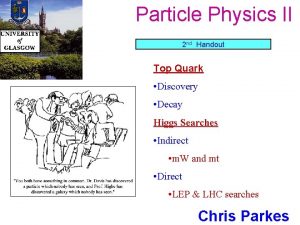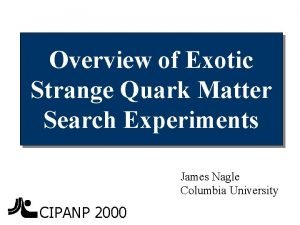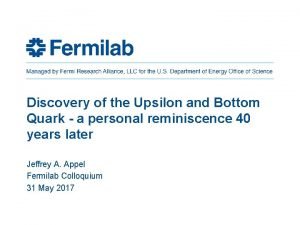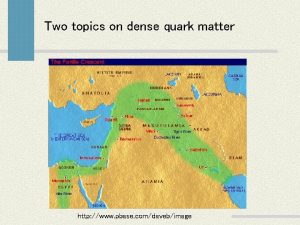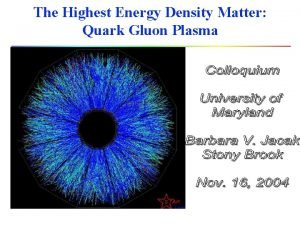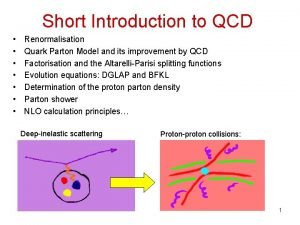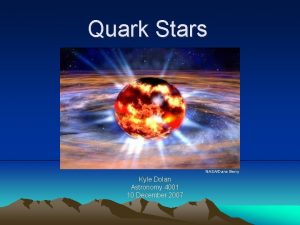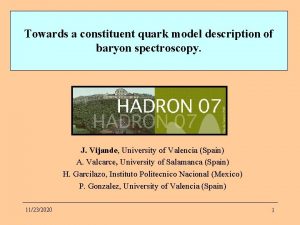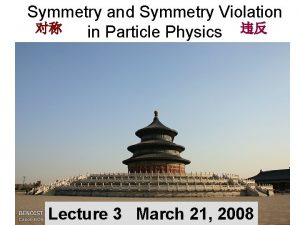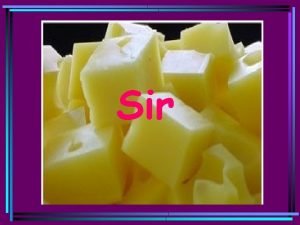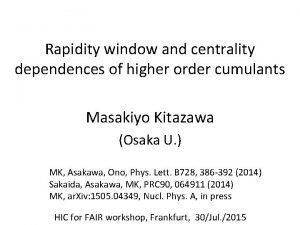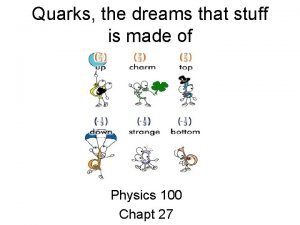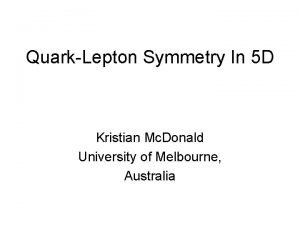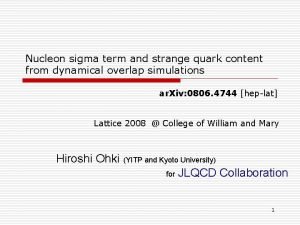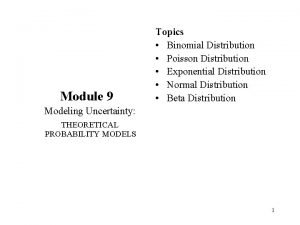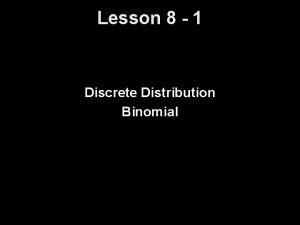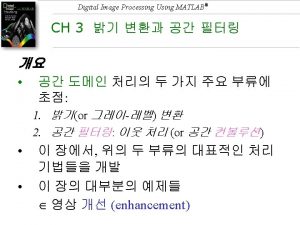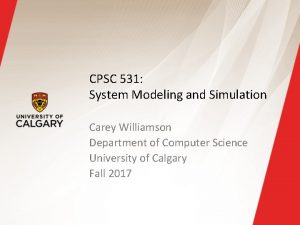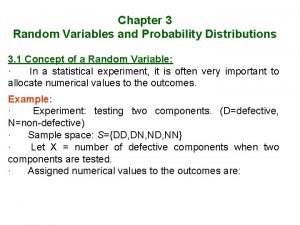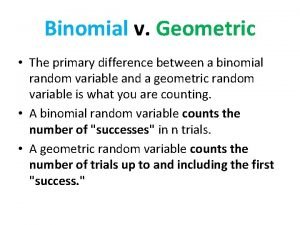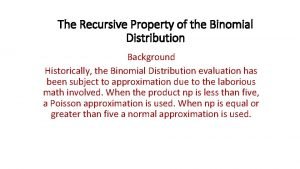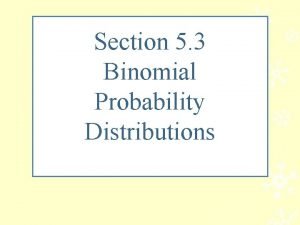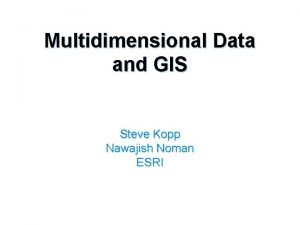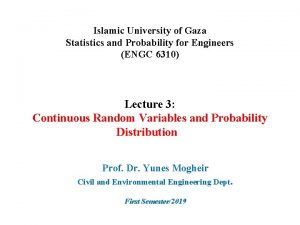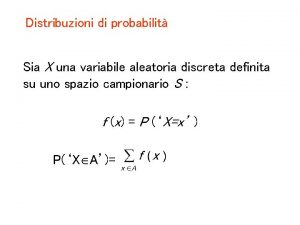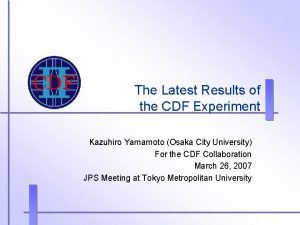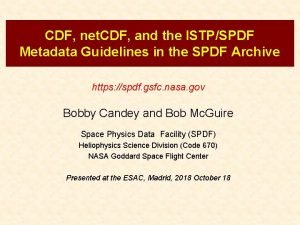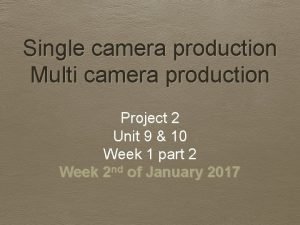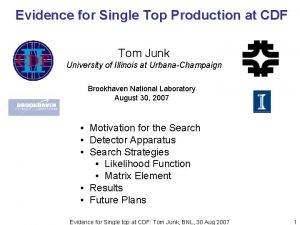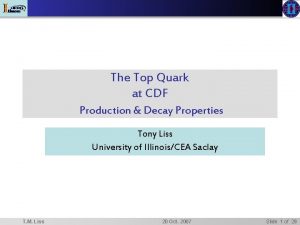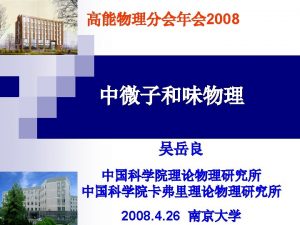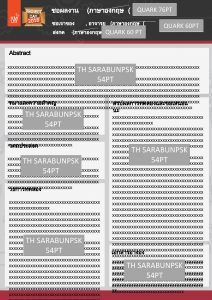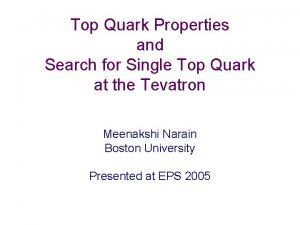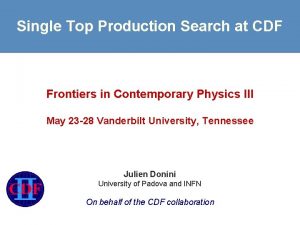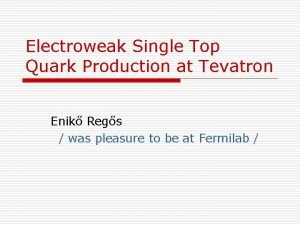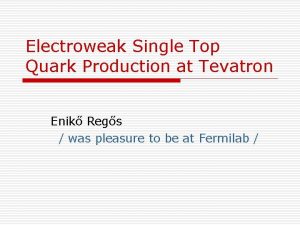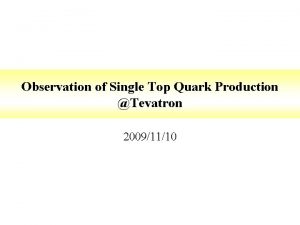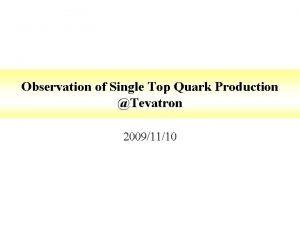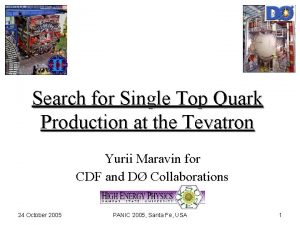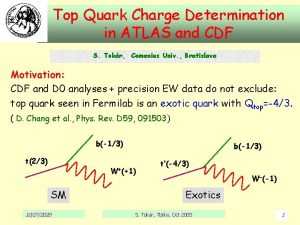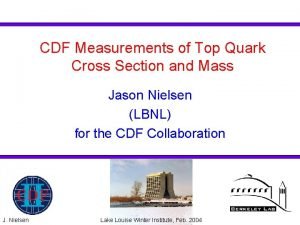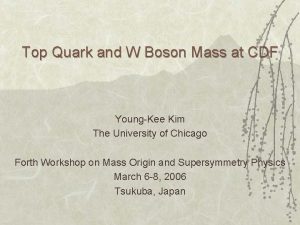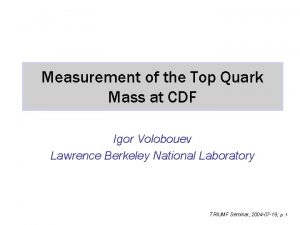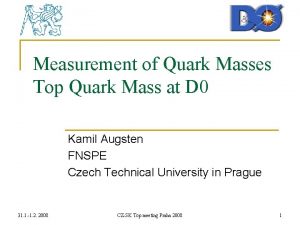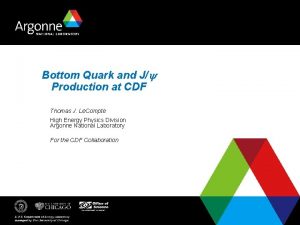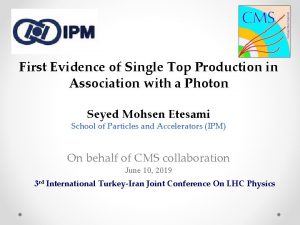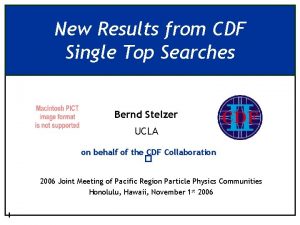Evidence for Single Top Quark Production at CDF





























































- Slides: 61

Evidence for Single Top Quark Production at CDF Bernd Stelzer University of California, Los Angeles� HEP Seminar, University of Pennsylvania September, 18 th 2007

Outline 1. Introduction to Top Quarks 2. Motivation for Single Top Search 3. The Experimental Challenge 4. Analysis Techniques • Likelihood Function Discriminant (1. 51 fb-1) • Matrix Element Analysis (1. 51 fb-1) 5. Measurement of |Vtb| 6. More Tevatron Results 7. Summary / Conclusions / Outlook 2

The Tevatron Collider • Tevatron is worlds highest energy Collider (until 2008) • Proton Anti-proton Collisions at ECM=1. 96 Te. V 3

Top Production at the Tevatron Once every 10, 000, 000 inelastic collision. . 4

Top Production at the Tevatron • At the Tevatron, top quarks are primarily produced in pairs via the strong interaction: vered o c s i D ! 1995 NLO = 6. 7± 0. 8 pb mt=175 Ge. V/c 2 • Single top quark production is also predicted by the Standard Model through the electroweak interaction: ( st ~ ½ tt) NLO t-channel = 1. 98± 0. 21 pb NLO s-channel = 0. 88± 0. 07 pb Cross-sections at mt=175 Ge. V/c 2, B. W. Harris et al. , Phys. Rev. D 70 (2004) 114012, Z. Sullivan hep-ph/0408049 5

Top Quark in the Standard Model • Top Quark is heaviest particle to date – mt=170. 9 1. 8 Ge. V/c 2 March 2007 – Close to the scale of electroweak symmetry breaking – Special role in the Standard Model? • Top Quark decays within ~10 -24 s - No time to hadronize - We can study a ‘bare quark’ >10 orders of magnitude! 6

Why measure Single Top Production ? • Source of single ~100% polarized top quarks: Direct measurements – Short lifetime, information passed to decay products – Test V-A structure of W-t-b vertex Ratio from Bs oscillations • Allows direct Measurement of CKMMatrix Element Vtb: Not precisely measured – single top ~|Vtb|2 – indirect determinations of Vtb enforce 3 x 3 unitarity Ceccucci, Ligeti, Sakai PDG Review 2006 Precision EW rules out “simple” fourth generation extensions, but see Vtb s-channel t-channel J. Alwall et. al. , “Is |Vtb|~1? ” Eur. Phys. J. C 49 791 -801 (2007). 7

Sensitivity to New Physics and Benchmark for WH • Single top rate can be altered due to the presence of New Physics: - t-channel signature: Flavor changing neutral currents (t-Z/γ/g-c couplings) Z c - s-channel signature: Heavy W boson, charged Higgs H+, Kaluza Klein excited WKK t • s-channel single top has the same final state as WH l bb => benchmark for WH! 1. 25 t (pb) W , H+ s (pb) Tait, Yuan PRD 63, 014018(2001) ( WH ~ 1/10 s-channe)) CMSSM Study: Buchmuller, Cavanaugh, de. Roeck, S. H. , Isidori, Paradisi, Ronga, Weber, G. Weiglein’ 07] 8

Experimental Challenge 9

Event Signatures Electron Top Pair Production with decay Into Lepton + 4 Jets final state are very striking signatures! Jet 1 Jet 3 Single top Production with decay Into Lepton + 2 Jets final state Is less distinct! MET Jet 2 Jet 4 10

CDF II Detector (Cartoon) ■ Silicon tracking detectors h = 1. 0 ■ Central drift chambers (COT) h = 2. 0 ■ Solenoid Coil ■ EM calorimeter ■ Hadronic h = 2. 8 calorimeter ■ Muon scintillator counters ■ Muon drift chambers ■ Steel shielding Single top analysis needs full detector! Thanks to great work of detector experts and shift crew! 11

CDF II Detector Central calorimeters Endplug calorimeters Central muon Drift chamber tracker Silicon detector 12

Data Collected at CDF This analysis uses 1. 51 fb-1 Delivered : 3. 0 fb-1 Collected : 2. 7 fb-1 (All detector components ON) Tevatron people are doing a fantastic job! 3 fb-1 party coming up! Design goal CDF is getting faster, too! 6 weeks turnaround time to calibrate, validate and process raw data 13

Single Top Selection Event Selection: • 2 Jets, ET > 20 Ge. V, | |< 2. 8 • Veto Fake W, Z, Dileptons, Conversions, Cosmics Electron CDF W+2 jet Candidate Event: • 1 Lepton, ET >20 Ge. V, | e( )|< 2. 0 (1. 0) Close-up View of Layer 00 Silicon Detector • Missing ET, (MET) > 25 Ge. V Jet 2 • At least one b-tagged jet, (displaced secondary vertex tag) 12 mm Run: 205964, Event: 337705 Electron ET= 39. 6 Ge. V, Missing ET = 37. 1 Ge. V Jet 1: ET = 62. 8 Ge. V, Lxy = 2. 9 mm Jet 2: ET = 42. 7 Ge. V, Lxy = 3. 9 mm Number of Events / 1. 51 fb-1 Jet Single Top Background S/B W(l ) + 2 jets 136 28300 ~1/210 W(l ) + 2 jets + b-tag 61 1042 ~1/17 14

B-quark Tagging and Jet Flavor Separation • Exploit long lifetime of B hadrons (c ~450 m)+boost • B hadrons travel Lxy~3 mm before decay with large track multiplicity Charm tagging rate ~10% Mistag rate ~ 0. 5% Neural Network Jet-Flavor Separator • Separate tagged b-jets from charm/light jets using a Neural Network trained with tracking information – Lxy, vertex mass, track multiplicity, impact parameter, semilepton decay information, etc. . . • Used in all single top analyses NN Output 15

Background Estimate W+HF jets (Wbb/Wcc/Wc) Top/EWK (WW/WZ/Z→ττ, ttbar) • W+jets normalization from data and heavy flavor (HF) fractions from ALPGEN Monte Carlo • MC normalized to theoretical cross-section Non-W (QCD) b • Fit low MET data and extrapolate into signal region tt Di non-W Z/ • Multijet events with semileptonic b-decays or mismeasured jets Wbb W+HF jets (Wbb/Wcc/Wc) Mistags Wcc Wc • W+jets normalization from data and heavy flavor (HF) fraction from MC Mistags (W+2 jets) • Falsely tagged light quark or gluon jets • Mistag probability parameterization obtained from inclusive jet data 16

Non-W Estimate • Build non-W model from ‘anti-electron’ selection • Require at least two non-kinematic lepton ID variables to fail: EM Shower Profile 2, shower maximum matching (d. X and d. Z), Ehad/Eem, • Data is superposition of non-W and W+jets contribution -> Likelihood Fit Before b-tagging: Signal Region After b-tagging: Signal Region 17

W + Heavy Flavor Estimate • Method inherited from CDF Run I (G. Unal et. al. ) • Measure fraction of W+jets events with heavy flavor (b, c) in Monte Carlo • Normalize fractions to W+jets events found in data Note: Similar for W+charm background Correct data for non W+jets events Heavy flavor fractions and b-tagging efficiencies from LO ALPGEN Monte Carlo Calibrate ALPGEN heavy flavor Fractions by comparing W + 1 jet Data with ALPGEN jet Monte Carlo KHF=1. 4 ± 0. 4 Large uncertainties from Monte Carlo estimate and heavy flavor calibration (36%) 18

Signal and Background Event Yield CDF Run. II Preliminary, L=1. 51 fb-1 Predicted Event Yield in W+2 jets s-channel 23. 9 ± 6. 1 t-channel 37. 0 ± 5. 4 Single top 60. 9 ± 11. 5 tt 85. 3 ± 17. 8 Diboson 40. 7 ± 4. 0 Z + jets 13. 8 ± 2. 0 W + bottom 319. 6 ± 112. 3 W + charm 324. 2 ± 115. 8 W + light 214. 6 ± 27. 3 Non-W 44. 5 ± 17. 8 Total background 1042. 8 ± 218. 2 Total prediction 1103. 7 ± 230. 9 Observed Single top swamped by background and hidden behind background uncertainty. Makes counting experiment impossible! 1078 19

CDF Data Monte Carlo Signal/Background Result Cross Section Analysis Event Selection Analysis Flow Chart Analysis Technique Apply MC Corrections Template Fit to Data Signal Background Discriminant 20

Analysis Techniques Likelihood Discriminant Matrix Element Analysis More Tevatron Results 21

The Likelihood Function Analysis Nsig Nbkg Unit Area Bkgr Wbb ttbar i, index input variable Signal tchan schan Discriminant Leading Jet ET (Ge. V) Uses 7 (8) kinematic variables for t-channel (s-channel) Likelihood Function e. g. M(Wb) or kin. Solver 2, HT, Qx. Eta, NN flavor separator, Madgraph Matrix Elements, M(jj) 22

Kinematic Variables HT = ET(lepton, MET, Jets) Background Wbb ttbar Signal Background tchan schan Signal tchan schan Wbb ttbar 23

Analysis Techniques Likelihood Discriminant Matrix Element Discriminant More Tevatron Results 24

Matrix Element Approach • No single ‘golden’ kinematic variable! • Attempt to include all available kinematic information by using Matrix Element approach • Start from Fermi’s Golden rule: Cross-sections ~ |Matrix Element|2 Phase space Calculate an event-by-event probability (based on fully differential cross-section calculation) for signal and background hypothesis 25

Matrix Element Method Event probability for signal and background hypothesis: Leading Order matrix element (Mad. Event) Input only lepton and 2 jets 4 -vectors! W(Ejet, Epart) is the probability of measuring a jet energy Ejet when Epart was produced Integration over part of the phase space Φ 4 Parton distribution function (CTEQ 5) c 26

Transfer Functions Full simulation vs parton energy: Double Gaussian parameterization: E pa rto n E jet E n pa rto E jet Double Gaussian parameterization: where: E = (Eparton–Ejet) 27

Event Probability Discriminant (EPD) • We compute probabilities for signal and background hypothesis per event Use full kinematic correlation between signal and background events • Define ratio of probabilities as event probability discriminant (EPD): ; b = Neural Network b-tagger output Background Signal 28

Event Probabilty Discriminant • S/B~1/17 over full range • Likelihood fit will pin down background in low score region S/B~1/1 In most sensitive bin! 29

Cross-Checks 30

Cross-Checks in Data Control Samples • Validate method in various data control samples • W+2 jets data (veto b-jets, selection orthogonal to the candidate sample) • Similar kinematics, with very little contribution from top (<0. 5%) px py pz E Lepton (Electron/Muon) Leading Jet Second Leading Jet 31

Cross-Checks in Data Control Samples • b-tagged dilepton + 2 jets sample • Purity: 99% ttbar • Discard lepton with lower p. T • b-tagged lepton + 4 jets sample • Purity: 85% ttbar • Discard 2 jets with lowest p. T CDF Run II Preliminary 32

Monte Carlo Modeling Checks 33

Template Fit to the data 34

Binned Likelihood Fit Binned Likelihood Function: Expected mean in bin k: βj = σj/σSM parameter single top (j=1) W+bottom (j=2) W+charm (j=3) Mistags (j=4) ttbar (j=5) k = Bin index i = Systematic effect δi = Strength of effect εji± = ± 1σ norm. shifts κjik± = ± 1σ shift in bin k ®All sources of systematic uncertainty included as nuisance parameters ®Correlation between Shape/Normalization uncertainty considered (δi) 35

Rate vs Shape Systematic Uncertainty Systematic uncertainties can affect rate and template shape • Rate systematics give fit templates freedom to move vertically only • Shape systematics allow templates to ‘slide horizontally’ (bin by bin) Rate and Shape systematics Discriminant 36

Sources of Systematic Uncertainty CDF Run. II Preliminary, L=1. 51 fb-1 Source Rate Uncert. Shape Uncert. W + bottom 36% W + charm 36% Mistags 15% ttbar 21% Non-W 40% 1. . 13% Initial State Radiation 3. 2% Final State Radiation 5. 3% Parton Dist. Function 1. 4% Monte Carlo Modeling 1. 6% Efficiencies/b-tag SF 5% Luminosity 6% Jet Energy Scale 37

Results 38

Matrix Element Analysis • Matrix Element analysis observes excess over background expectation • Likelihood fit result for combined search: 39

ME Separate Search • Perform separate likelihood fit for s-channel and t-channel signal • Both signal templates float independently s-channel +1. 0 s=1. 1− 0. 8 pb t-channel +1. 0 t=1. 9 − 0. 9 pb 40

Likelihood Function Discriminant • Likelihood Function analysis also observes excess over background expectation • Observed deficit previously in 0. 955 fb-1 41

Likelihood Function 2 D Fit 42

Signal Significance 43

Hypothesis Testing L. Read, J. Phys. G 28, 2693 (2002) T. Junk, Nucl. Instrum. Meth. A 434, 435 (1999) • Calculate p-value: Faction of backgroundonly pseudo-experiments with a test statistic value as signal like (or more) as the value observed in data 3. 1 • Define Likelihood ratio test statistic: Evidence More signal like Less signal like • Systematic uncertainties included in pseudo-experiments • Use median p-value as measure for the expected sensitivity Median p-value = 0. 13% (3. 0 ) Observed p-value = 0. 09% (3. 1 ) 44

Hypothesis Testing More signal like Less signal like Median p-value = 0. 20% (2. 9 ) Observed p-value = 0. 31% (2. 7 ) 45

Signal Features 46

Single Top Candidate Event Central Electron Candidate Charge: -1, Eta=-0. 72 MET=41. 85, Met. Phi=-0. 83 Jet 1: Et=46. 7 Eta=-0. 61 b-tag=1 Jet 2: Et=16. 6 Eta=-2. 91 b-tag=0 Qx. Eta = 2. 91 (t-channel signature) EPD=0. 95 Jet 1 Run: 211883, Event: 1911511 Lepton Jet 2 47

Single Top Signal Features Look for signal features in high score output EPD>0. 95 EPD>0. 90 48

Qx. Eta Distributions in Signal Region EPD>0. 9 3) EPD>0. 95 4) 49

m(W, b) Distributions in Signal Region EPD>0. 95 50

Unconstrained Likelihood Fit Remove all background normalization constraints and perform a five parameter likelihood fit (all template shapes float freely) Best fit for signal almost unchanged. Uncertainty increased by about 20% 51

Direct |Vtb| Measurement • Using the Matrix Element cross Section PDF we measure |Vtb| • Assume Standard Model V-A coupling and |Vtb| >> |Vts|, |Vtd| s-channel t-channel Flat prior 0 < |Vtb|2 < 1 |Vtb|= 1. 02 ± 0. 18 (experiment) ± 0. 07 (theory) |Vtb|>0. 55 at 95% C. L. Z. Sullivan, Phys. Rev. D 70 (2004) 114012 52

Single Top Results from DØ 53

D 0 Results Boosted Decision Tree 3. 4 Evidence First direct limit on Vtb: 0. 68 <|Vtb|< 1 @ 95%CL or Expected p-value = 1. 9% (2. 1 ) Observed p-value = 0. 04% (3. 4 ) |Vtb| = 1. 3 ± 0. 2 PRL 98 18102 (2007) 54

Summary of Results Summary Expected Observed 3. 0 3. 1 2. 9 2. 7 2. 6 2. 1 3. 4 1. 9 3. 2 2. 7 Combined: 2. 3 / 3. 6 • CDF analyses more sensitive • D 0 observes upward fluctuation In 900 pb-1 of data 55

CDF Single Top History 2006: Established sophisticated analyses Check robustness in data control samples 2004: Simple analysis while refining Monte Carlo samples and analysis tools Phys. Rev. D 71 012005 2 Years • Development of powerful analysis techniques (Matrix Element, NN, Likelihood Discriminant) • NN Jet-Flavor Separator to purify sample • Refined background estimates and modeling • Increase acceptance (forward electrons) • 10 x more data First Tevatron Run II result using 162 pb-1 single top < 17. 5 pb at 95 % C. L. 2007: Evidence for single top quark production using 1. 5 fb-1 (expected and observed!) 56

Conclusion • Evidence for electroweak single top quark production at the Tevatron established by CDF and D 0 experiment! • First direct measures of CKM matrix element |Vtb| • Advanced analysis tools essential to establish small signals buried underneath large backgrounds • Entering the era of single top physics. 4 -5 sigma observation possible with >3 fb-1 of data - Perhaps CDF is lucky this time. . • Separate s-channel from t-channel, measure more top properties, e. g. top polarization etc. . • Exciting times! The race for first observation is on. . • Important milestone along the way to the Higgs! 57

Search for Heavy W Boson • Search for heavy W boson in W + 2, 3 jets • Assume Standard Model coupling strengths W (Z. Sullivan, Phys. Rev. D 66, 075011, 2002) • Perform fit to MWjj distribution Previous Limits: • CDF Run I: M(W R) > 566 Ge. V/c 2 at 95% C. L. • D 0 Run II: M(W R) > 630 Ge. V/c 2 at 95% C. L. Limit at 95% C. L. M(W´) > 760 Ge. V/c 2 for M(W´) > M(νR) M(W´) > 790 Ge. V/c 2 for M(W´) < M(νR) 58

LHC is the Future Large Hadron Collider 59

LHC is the Future Additional single top process at the LHC! (negligible at the Tevatron) • LHC will be a top quark factory üσtt ~ 800 pb Wt- production ü σt-channel ~ 243 pb (153 pb for top and 90 pb for antitop production) ü σs-channel ~ 11 pb (6. 6 pb for top and 4. 8 pb for antitop production) ü σWt ~ 50 -60 pb (negligible at the Tevatron) • First precision t-channel measurement (10%) expected after 1 st year of running (10 fb-1/year) • s-channel measurement harder because of small cross section and large backgrounds (sounds familiar!) • The associated Wt production is tough because of large top-pair background (W+3 jets signature) 60

Backup Slides Backup 61
 Top quark decay
Top quark decay Post production adalah
Post production adalah Quark physics wordle
Quark physics wordle Quarks
Quarks Quark names
Quark names Barbara pasquini
Barbara pasquini Quark gluon
Quark gluon Quark gluon
Quark gluon Quark parton model
Quark parton model Quark astronomy
Quark astronomy Quark gluon plasma
Quark gluon plasma Quark names
Quark names Constituent quark model
Constituent quark model A charm quark has a charge of approximately
A charm quark has a charge of approximately Dimsi sir
Dimsi sir Quark gluon plasma
Quark gluon plasma Quark types
Quark types Quark lepton symmetry
Quark lepton symmetry Sigma quark composition
Sigma quark composition Quark matter 2022
Quark matter 2022 Tevatron cdf
Tevatron cdf Cdf vs pdf
Cdf vs pdf How to use binomial cdf
How to use binomial cdf How to use binomial cdf
How to use binomial cdf Cdf esa
Cdf esa Matlab cdf 그리기
Matlab cdf 그리기 Cdf for uniform distribution
Cdf for uniform distribution P(0
P(0 Difference between binomial and geometric
Difference between binomial and geometric Cdf-s xt1
Cdf-s xt1 Binomial cdf
Binomial cdf Binom cdf
Binom cdf Net cdf
Net cdf Cdf of an exponential distribution
Cdf of an exponential distribution Cdf certification
Cdf certification Cdf variabile aleatoria
Cdf variabile aleatoria Cdf
Cdf Cat in image processing
Cat in image processing Cdf net
Cdf net Primary evidence vs secondary evidence
Primary evidence vs secondary evidence Primary evidence vs secondary evidence
Primary evidence vs secondary evidence Secondary sources
Secondary sources Primary evidence vs secondary evidence
Primary evidence vs secondary evidence Primary evidence vs secondary evidence
Primary evidence vs secondary evidence Are fibers class evidence
Are fibers class evidence Class evidence vs individual evidence
Class evidence vs individual evidence Explain how class evidence may be useful.
Explain how class evidence may be useful. A pair of latex gloves was found at a crime scene
A pair of latex gloves was found at a crime scene The absence of evidence is not evidence of absence meaning
The absence of evidence is not evidence of absence meaning Single camera techniques
Single camera techniques Multi strand narrative
Multi strand narrative Soft pvc formulation
Soft pvc formulation Multiple instruction single data example
Multiple instruction single data example Dataxin
Dataxin Multi channel multi phase example
Multi channel multi phase example Formuö
Formuö Typiska drag för en novell
Typiska drag för en novell Nationell inriktning för artificiell intelligens
Nationell inriktning för artificiell intelligens Returpilarna
Returpilarna Varför kallas perioden 1918-1939 för mellankrigstiden
Varför kallas perioden 1918-1939 för mellankrigstiden En lathund för arbete med kontinuitetshantering
En lathund för arbete med kontinuitetshantering Adressändring ideell förening
Adressändring ideell förening
